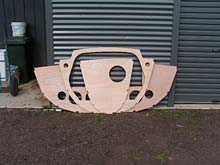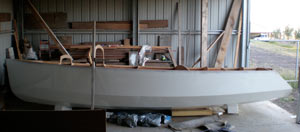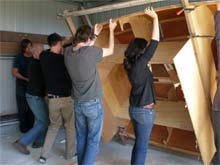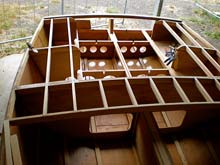
It had to be a wooden boat |
It had to be a wooden boat, but the choices out there are amazing and it takes some careful sifting to sort them into a useful set of categories. We wanted a roomy boat, capable of covering a bit of distance with sufficient shelter and storage for camp cruising or comfortable day sailing. We needed room for some snorkelling gear and a rod or two because my dream for this boat was for it to add something to our family recreation as a growing group, mainly of adults, and this added a subtle shift in thinking, away from the more traditional of the wooden boat designs. Two of our adult sons raced in yachts when at school, and one in particular was fond of a turn of speed. In fact, racing was still not entirely out of the question…
I had never built a boat before, but had dreamt of doing so since early childhood. I remember pursuing my 5th grade woodwork teacher relentlessly to allow me to make a plywood kayak that I had found drawings for. Of course he resisted me, but I loved those drawings; the stringers, the holes cut in bulkheads and those marvellous curves. Even before that, my first sight of a boat on a local lake when I was about four caused me to appropriate a fruit box and two old fence palings and hammer them together on the driveway of our house, imitating the shape of the boat. It didn’t float. Since then I have had experience of various techniques in making things from wood. We have the room and the tools, and I am definitely loopy enough to enjoy an improbable new challenge.

Bulkheads |
The boat that we ultimately chose could be seen as a modern interpretation of the popular (typically) homebuilt trailer yacht designed by Hartley, built in huge numbers, particularly in Australia and New Zealand. I have to admit that not getting a response to my enquiries from a couple of designers shifted the balance further in favour of this boat, when I was able to have a helpful and reassuring chat on the phone to Mike Waller. I also liked the idea of supporting a professional from my own country.
The Navigator was a candidate. There’s no denying the charm it has, particularly from the rear, but to my eye it was just a bit too sweet and curvy, and there was something about the resolution of those curves at the bow…I acknowledge though, that I’ve spent many happy hours pouring over photo sets of some very beautiful Navigator builds. Yuko in particular is just made for the camera, what a lovely job Barrett has made of her. That design has a very universal appeal, but not quite to me at the moment. Therein is the rub. There is no perfect boat, just different combinations of compromises for particular needs that one has at the time. If I do a second boat (and I certainly hope I do) it will be more just for this middle aged couple, more for harmony than speed, and more from a working tradition than a recreational one. I’m sure all boat watchers can visualize themselves with many different boats for many purposes. Very promiscuous in a way. There are already discussions underway with a designer in the UK, and he is working up some ideas for me from lines that I like, but don’t tell the family.

Side view |
There are other boats that I’d like to build simply because I admire the way they are designed, or because they have some shapes that I’d enjoy recreating. Ross Lillistone has a couple of lovely beach-cruisers in his ‘Phoenix III’,‘Periwinkle’ and ‘First Mate’ designs. If you go to the beach a lot (which we don’t) these are the type of boats that may never get dry because they are just so useable. They are of a tradition without being self-consciously traditional.
The area of water we’ll use most is likely to be Corio Bay and Port Philip in Victoria, Australia. These are vast bays and there is a lot of coast to explore, and we have a big, grown up, extended family, so a beamy 18 footer seemed a good size, balancing multi-tasking and capacity with portability.
Mike Waller is a marine architect who developed (amongst other designs, most notably multi-hull cruisers) a round bottomed, cold-moulded hull for a particular club to race, and by all accounts they were fast and capable yachts. A multi-chine version with a slightly more beginner-friendly construction method using modern epoxy/ ply methods was a development from that. I was first drawn to it because of the proportions and shapes in the side elevation. It was that simple! The boat is powered by a good acreage of Marconi rigged sail and has a self-draining cockpit and high, racing-dinghy-style deck seating, and a cabin for the feint-hearted. There is a fair amount of freeboard and the hull shape itself makes for a potentially dry and stable boat, but the cockpit arrangement allows for a wet and exciting ride if the skipper wants to push the rigging. This is the only sort of ‘hanging out’ that I hanker for these days.

The drawings |
The plan set was certainly daunting on first inspection. It was obvious that this was going to be a big project but as it has transpired, not a bad one for a first time builder who is prepared for a long haul. The drawings are very detailed on many large sheets and no serious lofting is required. The explanatory notes are also quite extensive and they contain sensible advice, anticipating the areas of probable difficulty. One of the advantages of Mike’s design is that it needs very little structure on which to build the hull. That means a quicker start and less expense for materials that don’t end up as part of the boat.
Looking at the literature and the web sites, it is apparent that for many people building a boat is an experience aimed at meeting emotional needs in the builder. Our modern lifestyle denies us many opportunities to actually make things for ourselves, and the promise of a boat and the process of bringing it into being can create a wonderful off-set for the pressure of getting through the working day, particularly in a city.

Components |
For many amateur boat builders it may be all about living within a poem in a small part of their mind while their actual experience is rather more like a mundane novel. Some will just talk about it and look at pictures and this is certainly the most relaxing and cost-effective way to go about things. Others are compelled by the actual business of sailing or boating and yet another group are doomed when seeing beautiful boats, by feeling compelled to experience and understand their workings by making versions of them. I fall into the third category.
Having digested the plans in an overview sort of way, I found the process of creating the parts for the sub-assemblies to be great fun. Nice materials, interesting shapes, lovely tools and most of all, imagining the way the bits would transform empty space in the shed when they were put together. One of the really wonderful moments in my life occurred when the bulkheads were all cut and my two adult sons and I stole a long, silly moment in the shed. Like little boys building a tree-house, we propped and clamped and leant the pieces along the floor to feel the internal space of the boat, and to imagine the shapes projecting themselves into the empty space. All of this despite the fact that the boat is built upside down. I guess you just had to be there, but I’m rather glad you weren’t!

Turning her over |
When family and some friends turned up for the turning of the boat it felt like it was the builder being blessed! The turning was the first occasion when the project received the collective interest of a group and it somehow felt that it was a worthy project and it was worthwhile spending all of this time ‘on the tools’, despite the inevitable self-doubt that plagues a person who is somewhat out of their comfort zone. Of course when the boat is turned you are tempted to believe that you are half way through the job, but the fit-out is littered with details and little to show for hours of work. Lots of joinery and fillets and fitting of small pieces that don’t actually contribute to her floatation like the outside of the hull did!
At the turning there stands before you a hull that could be put in the bath to play with, if there was a tub big enough. This is when it is time, once again, to put aside thoughts of a finished boat and concentrate on finding joy and delight in the sub-assemblies and single tasks. They all add up, they all accumulate, but they need to be enjoyed just for themselves.

Components |
I think the trick in building is to love the minor goals. If you are hell-bent on achieving the finished product you’d be better off buying a boat. Some amateurs become really hung up on achieving perfection, but I’d rather try for an object that seems lively, relaxed and hand-made than perfect, polished and wrapped in cotton-wool. For us, the hope is that the joy of building will add a certain depth, or another dimension to the joy of using.
***** |

